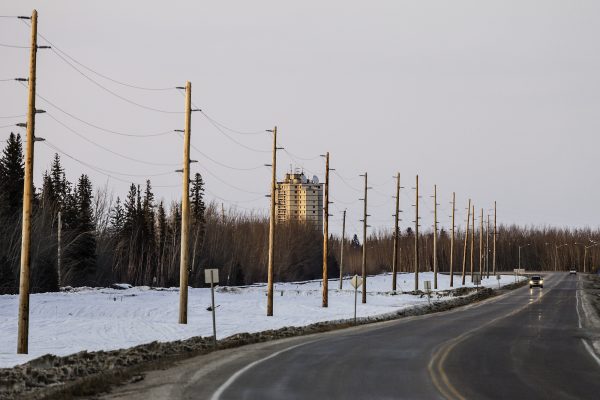EDITOR’S NOTE: In Spacing #29/2013, photographer Jesse Colin Jackson and anthropologist Lindsay Bell wrote about MacKenzie Place, the tallest residential building in Canada north of the 60th parallel. In support of Jackson’s new exhibition “Mackenzie Place” at Pari Nadimi Gallery (254 Niagara Street, Toronto, opening Thursday, March 23rd, 6-8pm) and the launch of Bell’s book Under Pressure: Diamond Mining and Everyday Life in Northern Canada (Saturday, May 13, 2-4pm), Spacing is republishing their feature, “Arctic Rising”.
ARCTIC RISING
Heading north from Edmonton, it’s a 975-kilometre drive to the 60th parallel. Travellers pull over and snap self-portraits with the polar bear sign: “Welcome to the Northwest Territories.” Between May and September, tourists drop into the 60th parallel visitor’s centre to claim their “Order of Arctic Adventurers” certificates. From here, the natural wonders of the Northwest Territories beckon: the Aurora Borealis, highway-blocking bison, world-class fishing and hunting, and more.
Keep driving due north of 60 to the shores of Great Slave Lake and you’ll arrive in Hay River, the second largest town in the Northwest Territories, population 4,000. Rail, river, and road meet here in what is known as the transportation “Hub of the North.” Marking the centre of town is an unlikely urban icon: the Mackenzie Place high-rise, the Territories’ tallest residential building. Like many places in Canada, the north is increasingly urban in nature — a quality that goes unnoticed by many southern visitors as they seek out the expected natural wonders.
Completed in 1975, the construction of the 17-storey high-rise residential tower was highly anticipated. The 80 units were to be filled by an influx of workers and residents that would accompany the proposed Mackenzie Valley Pipeline. The pipeline would carry oil and gas from the Beaufort Sea southward to the railhead in Hay River, where it would leave for refineries farther south. The pipeline project was defeated due to a mix of Aboriginal activism, changing Canadian policy towards Aboriginal lands, and a substantial drop in the price of oil. The building has never been filled to capacity.
While a postwar tower jutting up from the sub-arctic landscape may seem unusual, northern Canada has been the site of many experiments in planned urbanization and modernization. Inuvik, known for its above-ground “utilidors” and brightly painted homes, was planned in the 1950s as part of larger Cold War efforts to develop and protect the north. Frobisher Bay, now known as Iqaluit, began as a military base and was expanded to become an administrative centre during these same years. The Mackenzie Place high-rise was part of a planned relocation of the original settlements, which were located along the lakefront on both sides of the river. The original town was prone to seasonal flooding when river ice would break up every spring. In 1963, federal administrators for the region decided that a “new town” would be developed farther up the river. Its centrepiece was the high-rise.
Physically, the Mackenzie Place high-rise has reached its best-before date. Its recently repainted exterior belies its inadequate insulation and tired mechanical systems. The original tower design included shops on the ground floor, conference facilities on the second, and the first coin-operated laundromat in town. These spaces have been repurposed many times. Most recently, the bottom floor was used as remedial classroom space for the nearby high school. Hay River’s lone radio station has been broadcasting from the second floor for the past 20 years. As in many towers, the residential units are stratified vertically, with the nicest units on the upper floors. They’re also stratified east to west, with the river side units seen to be more desirable than the town side units, both because of the view and because of their superior satellite television orientation.
Tower life is not part of most people’s vision of the north as an unruly and unspoiled wilderness. This view is part of our national mythology, but this unlikely northern icon disturbs our collective sense of place. However, from almost every vantage point, the tower is the standout feature in Hay River. It is the only building of its type for over 1,000 kilometres, and yet, by virtue of Hay River’s isolation, the tower is by and large a sight unseen. Those who visit will find that many locals don’t know what to make of the place. For locals, the high-rise went from being a promise of a modern future to an all-too-present eyesore. Unlike many urban towers down south, however, this one singularly dominates in the centre of town and the surrounding landscape, serving as a constant visual anchor of the Hay River experience. Visually, it’s Hay River’s CN Tower.
Locals claim the high-rise is an epicentre of drug activity and complain about the owner’s failure to contribute to the town’s beautification efforts. When the buildinghas garnered outside attention, the focus has been on violence and tragedy. A young woman who moved up from Alberta suspiciously fell from the 16th floor. This was shortly followed by reports that a jealous ex-partner killed a local fisherman and his wife there. These anomalies easily overshadow the everyday life of those in the tower.
Those who move into the high-rise see it as a stepping-stone. For Ivan, Hay River wasn’t supposed to be his “forever home.” In 1978, his family fled Chile just as military dictator Augusto Pinochet had come to power. Ivan arrived just as a nearby lead and zinc mine was moving into full production, and getting work proved easy. Ivan explains: “Being an immigrant and coming up here is like winning the lottery. When we arrived, they were desperate for help. [My] dad took a job as a janitor for $1,000 a week and could not believe it! Although my father had been wealthy in Chile, we became servants, but we were well-treated, so that was confusing to us.” What was supposed to be a brief stay before moving to Miami lasted much longer.
Other residents still are eager to go home. Adore, an engineer from the Philippines, moved north to save money in the hope of returning sooner to his home country. He uses his second bedroom as a mini–recording studio. On any given Saturday or Sunday, you can find him behind an electric piano, wearing headphones, recording songs he has written or adapted, so he can send home CDs to his wife and children. He came to Canada seven years ago and has yet been unable to return to visit them.
Destiny, a 22-year-old Dene woman from the nearby First Nation, folds baby clothes she buys each week at the town’s local thrift shop. For her, the high-rise means doing things “her way.” Like many young adults, Destiny wants to feel in charge of her life. With a baby on the way, she hopes that moving to a bigger town in the Northwest Territories will offer her more job prospects. For Mary, a nurse practitioner originally from Ontario, the high-rise is the road out of many more years of work. She came north to save for retirement. She sits at her dining room table painting pieces of driftwood she collects at the beach on her morning walks with her pug, Oscar. “This place has everything I need. At my age, you have learned that it doesn’t take much to keep on,” she laughs.
The modern concrete residential tower — and its associated physical and existential problems — is no longer an image associated with progress in Canada. Nevertheless, understanding the evolving function of these multi-unit dwellings is fundamental to understanding a community’s strengthening — or weakening — heart. Hay River is no exception. The Mackenzie Place high-rise is threaded into the fabric of the town. Hay River, the north, and even Canada in the broadest sense, cannot be understood without understanding the high-rise and the stories it holds.
photos by Jesse Colin Jackson
Jackson has spent much of his career looking at tower apartment buildings, mostly ones structured of reinforced concrete. The buildings, the material, and their ethos emerged in the early modern period, seemingly without precedent, and have since proliferated beyond our wildest imagination. His new show Mackenzie Place is derived from extended consideration of a unique example of the type. Hay River’s unique concrete tower is far from its typical urban home, rising alone on the south shore of Tucho (Great Slave Lake), in Canada’s Northwest Territories. In 2013, Jackson and Bell began a research-creation collaboration at the intersection of art and anthropology that has now come to fruition. Mackenzie Place will immerse you in what the building sees, how it is seen, and the lives lived within its walls.
“Arctic Rising” was originally published in Spacing #29 (fall 2013)





One comment
“It is the only building of its type for over 1,000 kilometres.”
This is factually incorrect. There’s almost an exact replica of this tower in Yellowknife, less than 500 kilometres away. Towers are not rare in Yellowknife, either.